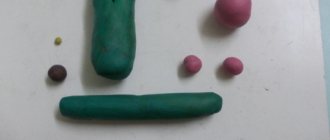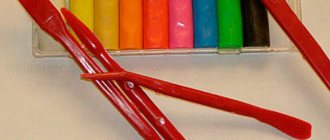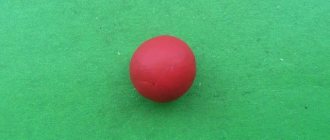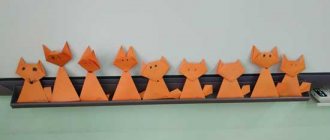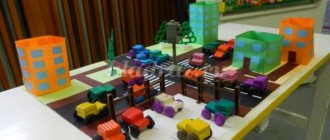Variations on the theme: individual and collective compositions
Traditionally, fish sculpting in the middle group is carried out in the first half of the year (November), then the children draw an aquarium composition. In general, the task of this lesson (“Different fish”) is to teach preschoolers to sculpt fish of the same shape, but differing in proportions. During such activities, children reinforce the modeling techniques they have previously learned.
However, different interpretations of this lesson are possible. You can designate its theme as “Goldfish”, having previously told the children, for example, the famous fairy tale by A.S. Pushkin. This craft will be slightly different from traditional fish: firstly, with its unusual color scheme, and secondly, with fabulous magical details (a crown on the head, a magic wand, etc.).
Children of middle school age are already able to understand the relationship between objects and objects; it is quite possible to introduce plot modeling. For example, propose a collective composition “Aquarium”. Such an activity will, of course, require preliminary preparation. The teacher prepares the base in advance - it can be a real empty aquarium or some other glass or plastic container of the required size. You can offer 2-3 small aquariums, dividing children into subgroups.
A possible variant of a modeling lesson is “Fish House”, in which each child makes his own aquarium. In such a lesson, in addition to plasticine, children can be offered cardboard (cut by the teacher into squares or rectangles of the required size - the walls of an aquarium), which the children will fasten with plasticine. One side of such a house should be made transparent by offering preschoolers pieces of plastic. Subsequently, the children “populate” such an aquarium with plasticine fish.
Appropriateness of using additional materials
Modeling a fish opens up great opportunities for using additional, natural or waste material. To effectively designate scales, you can use cereals (rice, buckwheat, pearl barley) or seeds. If the guys create a fabulous fish, foil or finely chopped bright candy wrappers will be useful to decorate its body.
In addition, modeling in class can be successfully combined with appliqué: a plasticine fish can have a tail or fins made of colored cardboard.
Implementation of an individual approach within the theme
In the middle group, many children show increased interest in modeling. Of course, such students need to be encouraged by offering them complex individual tasks. For example, if a child quickly and efficiently completes a task, the teacher can offer him to sculpt another fish, but only of a different shape, color and size. Another option is to decorate your fish, for example, using a felt-tip pen cap to make a beautiful design of scales or make it more colorful using scrap material.
MAGAZINE Preschooler.RF
Notes on modeling for children of the middle group “Dishes for dolls”Goal: Expand children's understanding of surrounding objects
Educational objectives:
- Strengthen children's ability to sculpt dishes.
- Practice sculpting techniques.
Developmental tasks:
- Activate vocabulary on the topic of tableware (sugar bowl, teapot, cups, saucers, thrush, spoons)
- Develop fine motor skills and eye.
Educational tasks:
- Arouse interest in teamwork to create a tea set for dolls.
- Foster activity, independence and accuracy in work.
Equipment. Doll dishes, bunny, plasticine, modeling board, stacks.
Preliminary work. Looking at tea sets at home, illustrations. D/I “Pick a Pair”
,
"What is missing"
.
Progress of the lesson.
1. Organizational moment.
The teacher leads the children to the group where the guests are sitting. Guys, look how many guests came to us! Let's say hello to them. (Children greet guests)
Children sit in a semicircle.
“Tea Party” by V. Shipunova
.
Like our Dunya’s cups and saucers, Like our Lyusenka’s little ones asking for tea:
- You are welcome - Come and visit. Come to visit. Come for some cookies
This is simply delicious - Visit the dolls on their birthday!
2. Game situation.
Educator. Guys, look who came to us? (Bunny)
A bunny came to us for help, he told me that the dolls and their friends want to have a party (a birthday, but they don’t have enough dishes. Let’s help the toys by making teaware for them.
Educator: Let's go with you to our workshop.
— Guys, look what’s on my table? (Tea-set)
There is a tea set on the table. Tell me what utensils are included in the tea set. (Children name: teapot, sugar bowl, cups, saucers, thrush; remind that all the items in the service are decorated the same way - polka dots, flowers, checkered patterns or something else. Children remember the tea sets they saw at home.
Comparison of dishes.
Educator: How are they different and similar: a plate and a saucer; cup and mug?
Game “Name what kind of dishes”
.
If the plate is made of plastic, then it is (what?)
-... If the spoon is made of metal, it is... If the cup is made of porcelain, it is... If the glass is made of glass, it...
If the sugar bowl is made of glass, then it... If the ladle is made of metal, it...
Physical education minute.
We begin exercises, standing in a circle, stretching our arms, jerking with our arms. Stretch your back and shoulders, turn right and left. To make it easier for us to sit.
Let's jump together, jump and jump! Jumping in place. Who will get the ceiling? Now walk in place. Walking. Let's all clap loudly together. Claps.
We quickly sat down at the tables and got down to business. Modeling cup and saucer.
Children make a plate out of a ball, flatten it and bend the edges a little, and decorate the plate with circles or stripes.
The cup is made from a ball, pressed a little into the middle, a handle is attached to the right. The cup can be made of any shape.
And before work, we will stretch our fingers.
Finger gymnastics “Knock-knock-knock”
.
Fingers came to visit,
Knock, knock, knock - they knocked on the door. Children tapping on the table
Only the door was not opened for them: with the pads of all fingers
They thought there was a terrible beast there. simultaneously.
The guys start working, they can implement any ideas. Offer to show the children some techniques for decorating tea cups, reciting all the actions ( “with a stripe”
— roll out a long flagellum and lay it along the rim - straight or in a wave).
Final part.
At the end of modeling, place all the works on the table and, together with the bunny, carefully examine them, draw the children’s attention to a more accurate representation of the shape of the dishes, to accuracy in work. Emphasize the variety of products and give them to dolls for their birthday.
| Next > |
Various options for crafts with comments and descriptions of execution methods
Most of the fish (photos 1–6) are made using a combined method: the head and body are sculpted from one large piece of plasticine, while the remaining elements (tail, fins, eyes) are attached separately.
are made using a combined method: the head and body are sculpted from one large piece of plasticine, while the remaining elements (tail, fins, eyes) are attached separately.
The fish in photo 4 “Goldfish” looks very impressive - a beautiful long red tail, detailed scales and bulging beady eyes.
Photo 5 “Aquarium with fish” shows modeling using the bas-relief method - the fish are attached to the surface, protruding approximately halfway. The original composition is complemented by pebbles, shells and algae.
The “Magic Fish” craft is of interest (photo 7): the body is made of a twisted flagellum. The gradient color (transition from pink to lilac) will look interesting.
Photos 9 and 10 show volumetric aquariums. Sea creatures are attached to the walls of the cans or fixed in the center on special fasteners.
Photo gallery: finished works of children
Crafts from plasticine
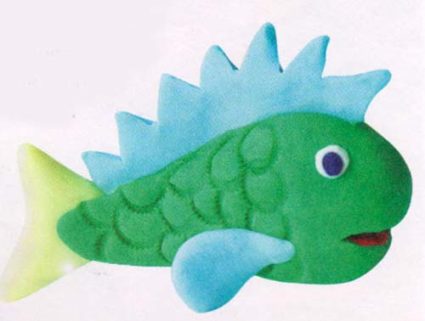
Plasticine craft
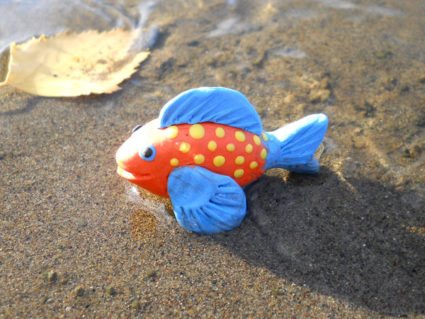
Plasticine craft

Plasticine with bead decoration
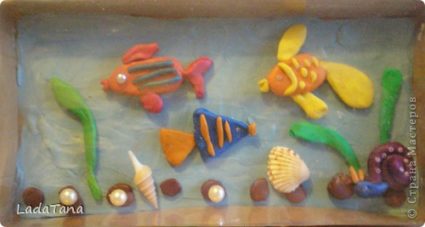
Bas-relief modeling
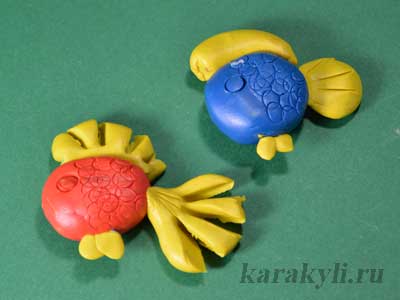
Crafts from plasticine
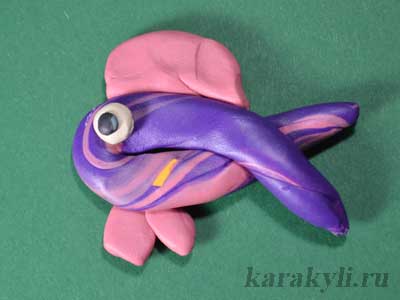
Fish created using an unusual technique
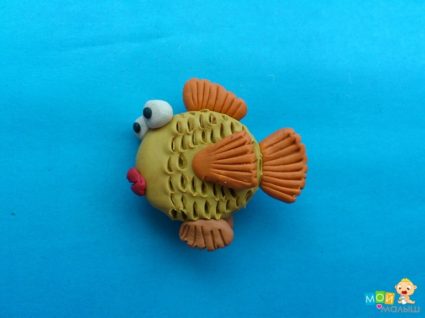
Crafts from plasticine Crafts
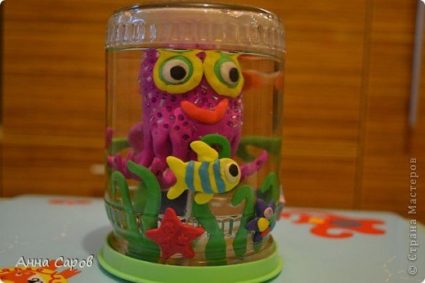
Craft
Video: sculpting “Goldfish”
https://youtube.com/watch?v=SaqF0GjJJ-0
Video: plasticine fish
https://youtube.com/watch?v=oPxRnrAsDeo
Video: cartoon “Wow, the talking fish” (1983)
Video: cartoon “In the blue sea, in white foam” (1984)
https://youtube.com/watch?v=wCpIuwelvwk
Video: “The Tale of the Fisherman and the Fish” by A. S. Pushkin
Most preschoolers love to sculpt, because this is an opportunity to create a new toy for themselves. Object modeling, which includes creating a fish, will certainly captivate children in the middle group, especially if the teacher introduces them to various options for creating the image of sea creatures. And the use of additional materials will make the lesson bright and memorable.
